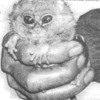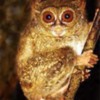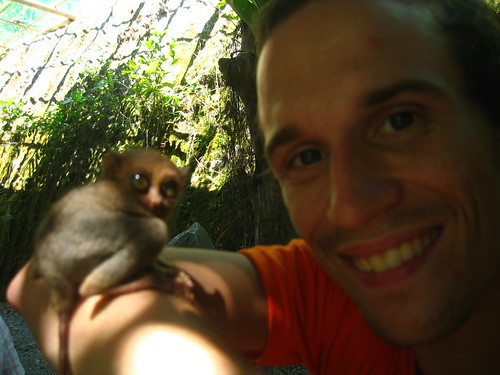Thank you for the post Inda.
I found some more information at the following website
http://animaldiversity.ummz.umich.edu/site/accounts/inf...Tarsius_pumilus.htmlTarsius pumilus
pygmy tarsier
Geographic Range
Tarsius pumilus known only from the central highlands of the island of Sulawesi, in Indonesia. (Musser and Dagosto, 1987)
Biogeographic Regions:
oriental (native ).
Other Geographic Terms:
island endemic .
Habitat
Elevation
1800 to 2200 m
(5904 to 7216 ft)
Tarsius pumilus is found in tropical mossy upper montane rain forests at elevations between 1,800 and 2,200 meters in the central Sulawesi mountains. The mountains are covered in a thick, gray mist when it is not raining. Humidity in these regions is 85 and 100%, creating a clammy, cold, and wet environment. The forest is usually open and parklike, blanketed in mosses with occasional tangles of rotting tree falls and dense undergrowth beneath. In upper montane forests, the canopy is only 10 to 20 meters high, leaves are small, tree trunks are not buttressed, large woody vines are absent, and species diversity of trees and shrubs is lower than in lowland tropical rainforest. (Musser and Dagosto, 1987)
Physical Description
Mass
80 to 165 g
(2.82 to 5.81 oz)
Length
85 to 160 mm
(3.35 to 6.3 in)
Of the four species of tarsiers, T. pumilus is one of the most morphologically distinct. Males and females are not sexually dimorphic. Tarsius pumilus is strongly distinguished by its small body size. Head and body length is 85 to 160 mm, only 75% that of the other three species of tarsiers. These animals weigh only 80 to 165 g.
Ears in this species are smaller than those of Tarsius tarsier. The pelage, similar to that of T. tarsier, is buff, predominantly gray or brownish-red. These two species also have in common a white, or pale brown, postauricular spot. Pelage of T. pumilus is longer, denser, and silkier than that of T. tarsier. Hair is sparse on certain parts of the body. The underbelly of T. pumilus is buff, grayish, or slate colored.
Tail length is 135 to 275 mm. The tail is heavily haired and dark brown or black. Approximately one third of the ventral surface of the tail is scaly, which is attributed to its function in body posture.
The most prominent structural features of tarsiers are their large, forward pointing eyes, usually 16 mm in diameter. Tarsius pumilus, like T. tarsier, has short fore limbs and small hands, suggesting that these animals use their hands more for locomotion than for immobilizing prey, as do other tarsier species.
Tarsius pumilus has nails on all five digits of the hand, including the hallux, and on the two lateral digits of the foot. These nails are laterally compressed and are sharply pointed at the tips, resembling claws. The specialized claw-like nails on T. pumilus have been attributed to their need for grasping strength in using large vertical supports for feeding and locomotion. The hands and feet of T. pumilus have digital pads that are reduced in size as compared to the digital pads on other species of tarsiers. This feature too, is thought to give T. pumilus a better grasp on the mossy substrate to which it clings during feeding and locomotion. Unlike other tarsiers, the tips of the nails extend beyond the edge of the digital pads. (Musser and Dagosto, 1987; Nowak, 1999)
A captive Tarsius syrichta lived for 13.5 years. It is likely that the lifespan of T. pumilus is similar. (Nowak, 1999)
Reproduction
Breeding interval
These animals are probably capable of breeding twice per year.
Breeding season
Breeding probably takes place at the beginning and end of the rainy season.
Little is known about reproduction in T. pumilus, possibly because this species was considered a subspecies of T. tarsier until recently. In T. tarsier, and possibly T. pumilus, there are two breeding seasons annually, spaced 6 months apart. One breeding season is at the beginning of the rainy season and the other at the end of the rainy season. Births occur in May and from November to December. (Musser and Dagosto, 1987; Nowak, 1999)
Despite lack of data, we can infer that T. pumilus resembles other tarsiers in basic reproductive patterns. In T. syrichta, gestation lasts 178 days, after which time a fully furred, well-developed offspring is born. Young cling to the mother's ventrum or are carried in the mouth. Because they are so precocial, the young rapidly develop the ability to follow along with their kin. A young tarsier is not able to leap until it is over one month of age, and it begins to capture prey at approximately 42 days of age. Weaning is thought to occur shortly afterward. (Musser and Dagosto, 1987; Nowak, 1999)
Key reproductive features:
iteroparous ; seasonal breeding ; gonochoric/gonochoristic/dioecious (sexes separate); sexual ; viviparous .
We have no information on parental care and investment in T. pumilus, but in closely-related T. tarsier the young mature relatively quickly; they can travel in groups 23 days after birth and are able to hunt alone after 42 days. Young females remain with their parents until adulthood, whereas young males leave their natal group as juveniles. (Musser and Dagosto, 1987; Nowak, 1999)
Parental investment:
precocial ; pre-fertilization (provisioning, protecting: female, female); pre-hatching/birth (provisioning: female, female, protecting: female, female); pre-weaning/fledging (provisioning: female, female, protecting: female, female); pre-independence (protecting: female, female); post-independence association with parents.
Behavior
Tarsiers are nocturnal or crepuscular and mainly arboreal. In the dense vegetation of its habitat, T. pumilus spends most of the day sleeping on vertical branches or possibly in hollow trees. When clinging to a vertical branch, the tail of T. pumilus is often braced against the vertical support and functions in supporting the body. When sleeping, the head of T. pumilus tends to drop downward between the shoulders. If disturbed while resting, these animals may move up and down the vertical support with the face presented towards the enemy, mouth open, and teeth bared. When waking, the ears of T. pumilus are furled or crinkled continuously.
These animals do not build nests. They have a wide field of vision and can rotate the head nearly 360 degrees. They can effortlessly leap several meters from tree to tree. Their leaps tend to be froglike. On a flat surface, their leaps can be from 1,200 to 1,700 mm long, and up to 600 mm high. The tail is arched over the back as an individual leaps. When walking on all fours, however, the tail hangs down.
Tarsius tarsier, and possibly T. pumilus, is territorial. These tarsiers actively chase others out of their home ranges and mark their core areas by rubbing the branches with urine and epigastric glands.
There is no evidence that anyone has ever recorded the vocalizations of the small bodied, montane T. pumilus. As a result, it is unknown whether the vocalizations of T. pumilus are similar to the loud shrieks during territorial battles and loud duets between the males and females found in T. tarsier, but it is likely that there is some similarity. (Musser and Dagosto, 1987; Nowak, 1999)
Key behaviors:
arboreal ; scansorial; saltatorial ; nocturnal ; crepuscular ; motile ; sedentary ; territorial ; social .
Communication and Perception
Tarsiers use chemical signals to mark their territories. In addition, although the calls of T. pumilus have not been recorded, other members of the genus do make vocalizations, which have some territorial significance. It is likely that T. pumilus is similar in this respect.
In all primate species tactile communication is important between mothers and their offspring, as well as between mates.
The extent to which tarsiers use visual signals, such as postures and displays, is not known. (Nowak, 1999)
Communicates with:
tactile ; acoustic ; chemical .
Other communication keywords:
scent marks .
Perception channels:
visual ; tactile ; acoustic ; chemical .
Food Habits
Tarsiers are primarily insectivorous. Tarsius pumilus eats primarily arthropods with heavily keratinized exoskeletons. Prey are caught by a sudden leap and chewed with a side to side motion of the jaw. Tarsius pumilus drinks water by lapping. (Musser and Dagosto, 1987; Nowak, 1999)
Primary Diet:
carnivore (insectivore ).
Animal Foods:
insects; terrestrial non-insect arthropods.
Predation
Details on predators of these animals are lacking. However, it is likely that small carnivorous mammals may take them as prey. In addition, they may fall prey to raptors and snakes.
Ecosystem Roles
As insectivores, these animals may help to structure the insect community and play an important role in local food webs.
Economic Importance for Humans: Negative
There are no known adverse affects of Tarsius pumilus on humans.
Economic Importance for Humans: Positive
There are no known positive effects of Tarsius pumilus on humans.
Conservation Status
IUCN Red List: [link]:
Data Deficient.
US Federal List: [link]:
No special status.
CITES: [link]:
Appendix II.
This species is only known from a handful of specimens, so the status of its population is very uncertain. The IUCN Red List therefore rates it "Data Deficient." However, the IUCN also notes that given its habitat requirements and limited range, it is likely to be endangered by deforestation (Shekelle and Salim, 2008). Pygmy tarsiers have only recently been collected and photographed alive.
The CITES treaty on the international trade in wildlife included all tarsiers in Appendix II, limiting international trade.








